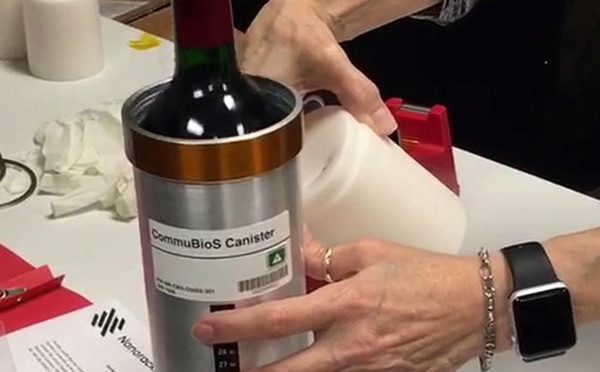Cheers! Alcoholic beverages in spaceby Chris Carberry
|
| When the whisky samples were returned to Earth in 2014, a clear difference was readily apparent from the control samples: the aftertaste was “pungent, intense and long, with hints of wood, antiseptic lozenges and rubbery smoke.” |
It’s not only whisky and wine producers interested in utilizing space to produce their products. At South by Southwest in Austin, Texas in 2017, American beer giant Budweiser announced it wanted to be the first beer producer on Mars. This wasn’t merely a publicity stunt. Since then, Budweiser has sent three barley experiments to the ISS. In a press release, Budweiser Vice President Ricardo Marques stated, “With this bold, new dream Budweiser is celebrating the entrepreneurial spirit in which our iconic brand was founded upon. Through our relentless focus on quality and innovation, Budweiser can today be enjoyed in every corner of the world, but we now believe it is time for the King of Beers to set its sights on its next destination. When the dream of colonizing Mars becomes a reality, Budweiser will be there to toast the next great step for mankind.”
People will unquestionably argue whether alcohol should be produced or consumed in space, but as private space enterprises and space tourism move forward, it becomes inevitable that alcohol will eventually be consumed and manufactured in space. To be clear, cosmonauts and astronauts have been consuming small amounts of alcohol in space for many years (as discussed in the new book Alcohol in Space.) However, and regardless of the perennial debate on the use of alcohol in society (and whether it is safe in space), the growing interest in space experiments and production from the alcohol industry is an intriguing development that could play an increasingly positive role in space exploration well beyond the ability to have a drink on the Moon or Mars. As the alcohol industry and other entities pursue technologies and methods harnessing the space environment, they are also helping to enable a sustainable human presence in space.
For example, as companies like Budweiser start investing in agricultural experiments in space, it represents a direct investment towards enabling long-term human habitation away from the relative safety of Earth. There have been several projects around the world that have experimented with the growth of barley, hops, and other traditional beer and alcohol-related crops in simulated Mars and Moon regolith.
The alcohol industry is not just pursuing agricultural endeavors. While not as significant a necessity as agriculture, one of the challenges being investigated relates to carbonated beverages such as beer and Champagne. On Earth, the gas in carbonated beverages rises to the top of the drink and disperses into the atmosphere. However, this does not occur in the microgravity environment in space. Those gas bubbles tend to converge in the center of the drink. This phenomenon also occurs in your stomach. As a result, astronauts have reported stomach cramps and wet burbs after consuming carbonated beverages—not the experience that beverage producers would hope to produce.
| The fact that so many companies and organizations are taking the prospects of space alcohol seriously, and also investing resources that could benefit many elements of space exploration, is a positive development. |
This problem has generated international interest. French Champagne producer Maison Mumm hopes to enable spacefaring bubbly drinkers to enjoy their products without the unpleasant side effects mentioned earlier. In 2018, they unveiled Mumm Grand Cordon Stellar, which is specially selected for an enjoyable drinking experience on orbit. Not only did they research which of their products would be an appropriate Champagne, but they also designed a special bottle and glass to enhance the “conviviality” of sipping their beverage.
An Australian collaborative effort has also been trying to solve the orbital carbonation issue. Saber Astronautics and 4 Pines Brewing Company teamed up to create a beer called “Vostok” with the goal of finding the right balance between carbonation and taste, enabling a pleasurable drinking experience.
The Vostok and Maison Mumm teams were able to sample their products in short periods of microgravity on parabolic flights. Perhaps more importantly, both companies have also created more efficient methods of dispensing their beverages, rather than the squeeze bottle approach that is usually employed in space. Vostok created a special insert to be used on a beer bottle and Maison Mumm designed an entire bottle specially designed for dispensing their product in microgravity. Other companies have been investigating fluid dynamics designing and building cocktail glasses as well as Scotch glasses to enable consumers to sip their drinks as they would on Earth. As the reality of private space travel and multi-year space missions appear to be closer than ever before, there are now numerous other alcohol-related space projects under way or already completed.
Unquestionably, consumption of alcohol, whether it be in space or on Earth, needs to be done responsibly, but the fact that so many companies and organizations are taking the prospects of space alcohol seriously, and also investing resources that could benefit many elements of space exploration, is a positive development. True sustainability in space will probably only occur when other “non-traditional” industries begin to invest in potential space applications, and how they may benefit their products back on Earth.
Note: we are temporarily moderating all comments submitted to deal with a surge in spam.
